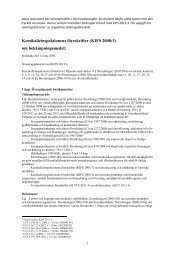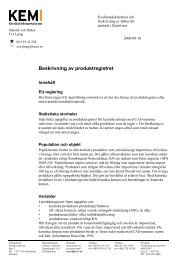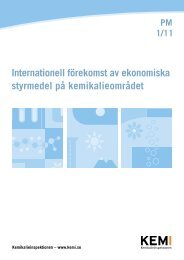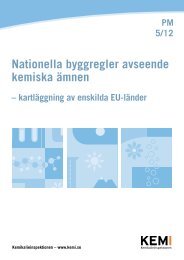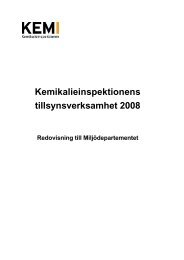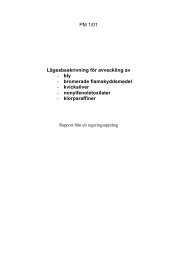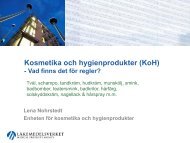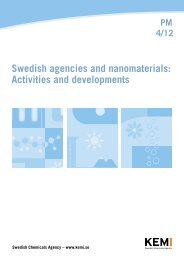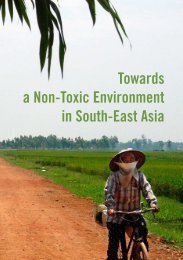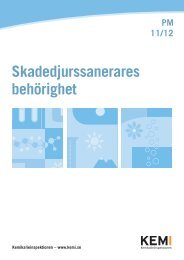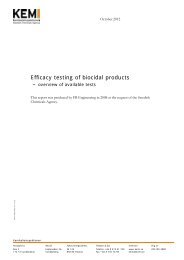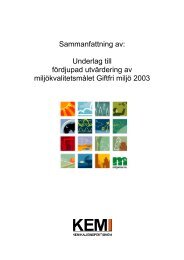KemI Rapport 3/06. - Kemikalieinspektionen
KemI Rapport 3/06. - Kemikalieinspektionen
KemI Rapport 3/06. - Kemikalieinspektionen
You also want an ePaper? Increase the reach of your titles
YUMPU automatically turns print PDFs into web optimized ePapers that Google loves.
According to the risk assessment, there is therefore no need for risk-reducing measureswith regard to health.The risk assessment for the environment is expected to be completed during 20<strong>06.</strong> TBBPAis persistent but does not otherwise meet the requirements for being defined as a PBTsubstance. The toxicity is, however, near the critical limit for a PBT substance.The handling of TBBPA in connection with the manufacture of epoxy resin and ABSplastic and the processing/manufacture of ABS compound, in which TBBPA is usedadditively to the ABS plastic, may pose risks to the environment on discharge. Industrialuse of the epoxy resin, in which TBBPA is reactively incorporated, for the manufacture ofarticles is not considered to give rise to any adverse effect on the environment. The fullyhardened resin contains only a very small proportion of residual unreacted TBBPA, and soleakage into the environment is limited.Diffuse emissions may occur via leakage from articles containing TBBPA, mainly in caseswhere the substance is only used additively, although measurements carried out on leakagefrom articles show that the leakage rate is very low.UseHBCDDHBCDD as a pure chemical substance is no longer used in Sweden. On the other hand,polystyrene that is flame-retarded with HBCDD is imported. Such import has, however,declined substantially in recent years, from around 120 tonnes in 1997 to 3.5 tonnes in2004. The flame-retarded polystyrene is bought in from suppliers in the Nordic region.Expanding and sawing into blocks then takes place at plants in Sweden. Flame-retardedEPS 11 is used mainly as insulating material in the construction industry, for example inwall elements on facades, insulation of bodies for buses and for partitioning walls inexhibition halls. The import of insulating material, i.e. ready-expanded (EPS) and readyextrudedpolystyrene (XPS), is not considered to be especially substantial. The material isbulky, which means that long transport operations are not cost-effective.The proportion of flame-retarded polystyrene in Sweden is, unlike in many other countries,extremely small. According to the plastics industry, only 0.5 per cent of the polystyreneused in Swedish buildings is flame-retarded with HBCDD. In the context of the EU 15,Swedish use of EPS flame-retarded with HBCDD accounted for less than 0.05 per cent oftotal EU use in 2000.HBCDD is no longer used in Swedish textile preparation. The import of special textilescontaining HBCDD is probably small-scale, but cannot be ruled out. Examples of textilesthat could be flame-retarded with HBCCD are vehicle upholstery and aircraft upholstery,and also special work clothing such as military uniforms and firemen’s clothing. A guideproduced by Textilimpörterna 12 urges the replacement of brominated organic flameretardant substances.11 Expanded polystyrene, also called frigolite or foamed plastic12 Textilimpörterna (2003) Guide to Buying Terms for the chemical content in textiles, clothing, leathergoods and shoes.16



